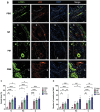Intervening to Preserve Function in Ischemic Cardiomyopathy with a Porous Hydrogel and Extracellular Matrix Composite in a Rat Myocardial Infarction Model
- PMID: 39491520
- PMCID: PMC11729544
- DOI: 10.1002/adhm.202402757
Intervening to Preserve Function in Ischemic Cardiomyopathy with a Porous Hydrogel and Extracellular Matrix Composite in a Rat Myocardial Infarction Model
Abstract
Multiple hydrogels are developed for injection therapy after myocardial infarction, with some incorporating substances promoting tissue regeneration and others emphasizing mechanical effects. In this study, porosity and extracellular matrix-derived digest (ECM) are incorporated, into a mechanically optimized, thermoresponsive, degradable hydrogel (poly(N-isopropylacrylamide-co-N-vinylpyrrolidone-co-MAPLA)) and evaluate whether this biomaterial injectate can abrogate adverse remodeling in rat ischemic cardiomyopathy. After myocardial infarction, rats are divided into four groups: NP (non-porous hydrogel) without either ECM or porosity, PM (porous hydrogel) from the same synthetic copolymer with mannitol beads as porogens, and PME with porosity and ECM digest added to the synthetic copolymer. PBS injection alone is a control group. Intramyocardial injections occurred 3 days after myocardial infarction followed by serial echocardiography and histological assessments 8 weeks after infarction. Echocardiographic function and neovascularization improved in the PME group compared to the other hydrogels and PBS injection. The PME group also demonstrated improved LV geometry and macrophage polarization (toward M2) compared to PBS, whereas differences are not observed in the NP or PM groups versus control. These results demonstrate further functional improvement may be achieved in hydrogel injection therapy for ischemic cardiomyopathy by incorporating porosity and ECM digest, representing combined mechanical and biological effects.
Keywords: extracellular matrix; hydrogel; myocardial infarction; porous structure.
© 2024 The Author(s). Advanced Healthcare Materials published by Wiley‐VCH GmbH.
Conflict of interest statement
The authors declare no conflict of interest.
Figures







Similar articles
-
Injectable, porous, biohybrid hydrogels incorporating decellularized tissue components for soft tissue applications.Acta Biomater. 2018 Jun;73:112-126. doi: 10.1016/j.actbio.2018.04.003. Epub 2018 Apr 10. Acta Biomater. 2018. PMID: 29649634 Free PMC article.
-
Synthetic extracellular matrix mimic hydrogel improves efficacy of mesenchymal stromal cell therapy for ischemic cardiomyopathy.Acta Biomater. 2018 Apr 1;70:71-83. doi: 10.1016/j.actbio.2018.01.005. Epub 2018 Jan 16. Acta Biomater. 2018. PMID: 29341932
-
Pericardial Delivery of Sodium Alginate-Infusible Extracellular Matrix Composite Hydrogel Promotes Angiogenesis and Intercellular Electrical Conduction after Myocardial Infarction.ACS Appl Mater Interfaces. 2024 Aug 28;16(34):44623-44635. doi: 10.1021/acsami.4c12593. Epub 2024 Aug 15. ACS Appl Mater Interfaces. 2024. PMID: 39145889
-
A novel, biodegradable, thermoresponsive hydrogel attenuates ventricular remodeling and improves cardiac function following myocardial infarction - a review.Curr Pharm Des. 2014;20(12):2040-7. doi: 10.2174/13816128113199990453. Curr Pharm Des. 2014. PMID: 23844737 Review.
-
Injectable hydrogel-based combination therapy for myocardial infarction: a systematic review and Meta-analysis of preclinical trials.BMC Cardiovasc Disord. 2024 Feb 21;24(1):119. doi: 10.1186/s12872-024-03742-0. BMC Cardiovasc Disord. 2024. PMID: 38383333 Free PMC article.
References
-
- Martin S. S., Aday A. W., Almarzooq Z. I., Anderson C. A. M., Arora P., Avery C. L., Baker‐Smith C. M., Barone Gibbs B., Beaton A. Z., Boehme A. K., Commodore‐Mensah Y., Currie M. E., Elkind M. S. V., Evenson K. R., Generoso G., Heard D. G., Hiremath S., Johansen M. C., Kalani R., Kazi D. S., Ko D., Liu J., Magnani J. W., Michos E. D., Mussolino M. E., Navaneethan S. D., Parikh N. I., Perman S. M., Poudel R., Rezk‐Hanna M., et al., Circulation. 2024, 149, e347. - PubMed
-
- Pfeffer M. A., Braunwald E., Circulation 1990, 81, 1161. - PubMed
-
- Mann D. L., Bristow M. R., Circulation 2005, 111, 2837. - PubMed
MeSH terms
Substances
LinkOut - more resources
Full Text Sources
Medical
Research Materials
Miscellaneous

